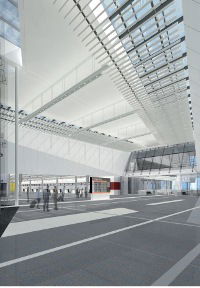When it comes to lighting circulation spaces such as corridors, both LEDs and fluorescent lamps are energy efficient. But which would win if they were to go head-to-head in identical conditions?

Which source offers the best energy savings: LED or fluorescent? It’s a question that is almost certainly being asked by cash-strapped building managers all over Europe. Zurich city council decided to settle the matter by conducting a test at two identical corridors in the city’s main administrative building.
Corridors that are simply transit areas or informal shortcuts appear to offer considerable scope to save energy in a building, particularly if there is little daylight. Artificial lighting might remain switched on for many if not all the hours of the working day, even when no-one is using the corridor.
Presence monitoring is one way to reduce energy use and costs, but the way it is done could affect users’ comfort as their eyes have to adjust to abrupt changes in light levels. Changing the light source could be another way to improve efficiency.
Fluorescent tends to be the source of choice to illuminate areas such as corridors – but could LEDs be more suitable? And what about the way each technology works with presence monitoring? Does this affect energy use? Zurich council’s Public Works Department teamed up with Eteam and Zumtobel to get some answers and find out which technology delivered the greater savings.
The contestants line up
In one corridor, a row of fluorescent lamps –19 35W T5s in Zumtobel Slotlight luminaires – were left as they were. Presence detectors with a 10-minute delay before switch-off were also left in place. In another, the fittings were converted to accommodate LED lamps – Zumtobel Slotlight continuous-row LED system, with each lamp rated at 23W.
In the LED corridor, the settings of the presence detectors were adjusted, with the switch-off delay reduced in a series of stages to one minute. This can be done with LEDs because frequent switching or dimming does not cause wear. The aim was to measure the effect of different delays, and the impact on user comfort. Illuminance levels and light distributions were identical in both corridors.
The test ran for four months. Regular measurements were made of the power consumption in each corridor.
How did they do?
The fluorescent lamp installation consumed 19.5kWh/m2. The LED fittings, in optimum operating mode – one-minute delay interval with no residual light after switch-off – consumed just 3.6kWh/m2 – a difference in energy use of 81 per cent.
The installed load with fluorescents was 5.9W/m2, which dropped to 2.6W/m2 with the LEDs. Actual the mains AC signal, thus providing less power to the light. The manual settings are provided by a switch that is operated by hand. Of course, the ultimate dimmed light source is one that is switched off, and dimming switches offer this option, of course.
Automatic systems rely on some external input to make a decision about what to do with the lights and this is where sensors and external controls become important. The main input types to the dimming or on/off process are:
- timer circuits,
- presence or proximity sensors,
- daylight or ambient light sensors,
- alarm signals, and
- programmable events.
These sensor or input circuits will respond to certain inputs and create an output signal that can be interpreted by the control gear to alter the drive conditions of the lamps, usually reducing the power into the lamp.
A special type of control is found in emergency lighting in which disruption of the power to the main luminaire causes a battery-operated circuit to become active, powering an emergency light.
The alteration of the drive conditions to dim lamps can be achieved in a variety of ways, depending on the lamp and electronics. Each one enables a change in the light level in a controlled manner in a defined relationship with the dimmer input signal.
There are different dimming methods for each lamp type. A system schematic for this more complex arrangement is shown below.
Networked solutions
When dealing with large numbers of luminaires or lamps in different locations, there are a number of networked technologies that control the light level of individual lights. Scenes are set by controlling lights in relation to each other to create a visual effect.
Two of the most popular systems are DMX512, which is a standard for digital communication networks that are commonly used to control stage lighting and effects.
The other is Digital Addressable Lighting Interface (Dali), which creates a flexible, cost-effective and decentralised lighting system. Dali was developed to replace the older analogue 1-10V dimming system. However, 1-10V is still highly popular for lower-cost systems.

Click here to register to receive your copy of Lux Review Magazine!
